Help and Advice
Specialist chemical safety advice is available on this page and on the University Safety Office webpages here.
The Department of Physics Chemical Safety Officer post is currently vacant. Contact the DSO for advice on purchase, handling, storage and disposal of substances, as well as on risk assessment.
You MUST obtain permission from Saba before buying hazardous substances that are labelled as 'fatal' by inhalation or ingestion or other routes of exposure, or can cause serious problems in small quantities.
If you have an urgent problem and Saba is not available, you can contact the University Safety Office's Physical and Chemical Safety Officer, John Hulme, on (01223 7)66353 or John.Hulme@admin.cam.ac.uk.
Summary
The law requires you to assess the risks from substances that could be hazardous, BEFORE you use them.
Important documents/guidance:
- University Safety Office Chemical Safety webpages and Chemical Safety guidance
- Hazardous Substance Use Risk Assessment forms
- COSHH Health Record forms
Scope
This page addresses the risks from chemical substances, including items that generate dust, fume, vapour or droplets. It excludes biological substances, which have their own page.
On this page you will find:
- The hazards associated with substances
- How exposure occurs
- What you need to know/find out in order to do your risk assessment
- How you assess the information in relation to your work
- Control measures and safe systems of work
- Health surveillance
- Buying & storing chemicals and disposing of waste
- Special topics:
- Nanoparticles
- Carcinogens, mutagens and substances toxic to reproduction
- Sensitisers
- Hydrofluoric acid
- Spillages and Other Emergencies
The hazards associated with substances
Note: In the next few years, the old orange or yellow signs are set to disappear to be replaced by the 'Globally Harmonised System' (GHS) of labels, which are diamond-shaped, generally white with a red border. This has the admirable aim of ensuring that, for instance, the term 'toxic' means the same everywhere in the world. Both sets of symbols are used below.
| Toxic substances | |
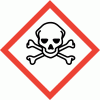 |
Toxic compounds cause death, disease or an interference with the normal bodily mechanisms. A very large number of substances have this ability, and the harm depends on the quantity that is encountered and in what form. To merit the 'toxic' sign, the toxicity is quantified in terms of the dose required to kill 50% of a population by inhalation or ingestion.
Very toxic substances are those where a small dose (e.g. < 25mg/kg body weight) has been shown to kill laboratory animals. Examples include thallium compounds, arsine, beryllium and cyanides. The toxin may have both long and short term effects and may attack a target organ remote from the site of entry. For example, ethanol has temporary effects on the central nervous system, but has chronic and sometimes fatal effects on the liver from repeated doses. It can also cause cancers of the throat. The response of one individual may be significantly different from another and there may be important age- or sex-related differences. |
 |
|
| Corrosive substances | |
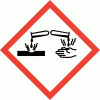 |
Corrosive substances attack human tissue on contact, burning it or otherwise destroying it. Common examples are mineral acids, alkalis and phenols. They present a hazard through direct contact with the skin or the eyes. If the fumes or mists of corrosive substances are inhaled they may damage the lungs or mucous membranes. If they are ingested they may damage the gastro-intestinal tract. Corrosive liquids pose very significant risks from splashes. |
 |
|
| Irritants | |
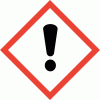 |
Irritants are substances that cause significant inflammation of the skin, persisting for more than 24 hours, or that cause defatting. Irritation of the eyes by substances classified as irritants can cause permanent damage.
A simple reaction to an irritant is local and is not normally extreme. However some irritants can provoke an allergic response and can give rise to occupational asthma or dermatitis. These substances are also sometimes classified as 'harmful'. Examples include pollens and flour dust. |
 |
|
| Harmful substances | |
 |
Harmful substances are those that can kill if encountered in large amounts by ingestion, inhalation, or skin absorption. This class also contains substances that can cause irreversible effects, possibly after a single exposure, or serious damage after prolonged or repeated exposure. Read the 'small print' in this class with great care!. |
 |
|
| Sensitising substances | |
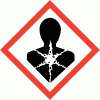 |
Some substances are known to cause asthma. The precise pattern of exposure leading to the disease is not known, nor is it possible to predict whether any particular individual will be likely to succumb. Two types of asthma can be identified - a type that is the direct result of exposure to an irritant and a type that is an allergic reaction to a substance that has been inhaled. Agents of the former type include sulphur dioxide, chlorine and fire smoke. Examples of the latter type include stainless steel welding fume, isocyanates and latex.
Asthmagens and substances that can cause dermatitis through skin contact are labelled with the 'harmful' symbol. Watch for the risk phrase R42 (inhalation) or R43 (skin) on the data sheet. |
 |
|
| Carcinogens, mutagens and substances toxic to reproduction | |
 |
Carcinogens can cause cancers. The body organ that is affected is frequently not the same as the site of exposure - so for instance, benzene is associated with leukemia.
Carcinogens are placed into one of three categories:
Work in categories 1 and 2 must be strictly controlled. The risk phrase is likely to be R45 or R49. Mutagens and substances toxic to reproduction can interfere with fertility, harm an unborn child or confer heritable genetic damage. These are categorised in a similar way to carcinogens, and the risk phrases to watch for include R46, R60, R61, R62, R63, R64. The University maintains a list of substances in categories 1 and 2. |
 |
|
| Flammability | |
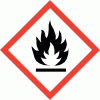 |
Flammability is classified on the basis of 'flashpoint' which is the temperature at which the vapour, when offered a source of ignition, burns briefly.
Extremely flammable substances have a flashpoint below 0oC and a boiling point below 35oC. Examples are acetylene, butane, diethyl ether. Highly flammable solids are those that catch fire readily after a brief exposure to a source of ignition and continue to burn are the source has been removed. Highly flammable liquids have a flashpoint below 21oC, but are not extremely flammable. Examples include ethyl acetate, isopropyl alcohol. Flammable substances have a flashpoint greater than 21oC but less than 55oC - they do not get a warning symbol. Examples include acetic acid, turpentine, xylene. |
 |
|
| Oxidising substances | |
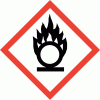 |
This category includes substances that can cause fire, even when not in contact with combustible materials (e.g. some organic peroxides). It also includes substances that can cause or enhance fire in contact with combustible material (e.g. inorganic peroxides). The category also includes substances that are explosive when mixed with combustible materials, such as some chlorates. |
 |
|
| Explosive substances | |
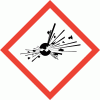 |
The explosive symbol is given to substances that have been found to be explosive in accordance with the tests in Annex V of the Directive 67/548/EEC. Examples are picric acid, PETN, certain organic peroxides.
Many substances that do NOT carry the symbol are nevertheless potentially explosive. Virtually any dust can explode - e.g. custard powder, flour, metal dusts. Gaseous and volatile substances such as methane, propane, ether, acetone, hexane etc can form explosive mixtures with air. |
 |
|
| Substances that can harm the environment | |
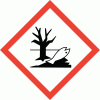 |
This category contains substances that can cause harm to wildlife, the ozone layer, watercourses or soil organisms. Watch for R50, R51, R52, R53, R54, R55, R56, R57, R58, and R59.
While we have sound policies for disposal of our normal waste, when something unexpected happens, such as a large-scale leak, we need to be aware of where the liquid is going, and the consequences. |
 |
|
How exposure occurs
There are three main routes of entry:
- inhalation,
- ingestion,
- skin absorption.
There are other possibilities, such as injection or puncture wounds.
Inhalation
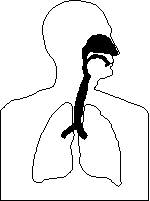 |
Where the particles go
Nasopharyngeal region: air velocity is high, particles of approximate diameter 5-30 μm are deposited. |
Inhalation is a major route of entry, since we pass more than 10 cubic metres of air through our lungs daily when we are at rest, and this can go up by a factor of more than ten when we take vigorous exercise.
The particle sizes beside the figure are a rough guide, relevant to spherical particles. Fibre-shaped particles can go a lot deeper than spherical particles of a similar diameter.
Insoluble particles deposited in the nasal passages tend to provoke sneezing, which expels them. The medium-sized particles are trapped by a moving 'carpet' of mucus that lines the airways. This 'carpet' is propelled by hairs, and will sweep the particles to the throat, where they are coughed out or swallowed.
The smallest particles reach the alveoli, where they either stay suspended in the air (and have a good chance of being exhaled) or are deposited and dealt with by large cells called macrophages. The macrophages engulf and destroy foreign material. Substances such as silica and asbestos damage the macrophages, causing an inflammatory reaction in the alveoli - a type of scarring known as lung fibrosis. This scarring can impair lung function. Some of these deposits can form carcinomas. Indigestible matter is removed from the lung via the blood stream or the lymph system, and may sometimes be found years later in the lymph nodes that drain the lung.
Soluble substances are readily absorbed at any point in the respiratory tract, and may cause a local reaction, such as excessive mucus secretion. From there they enter the bloodstream, and are free to travel to their target organ - the organ that is most vulnerable to their harmful effects. Many inhaled pollutants can cause damage to DNA, and hence eventually lead to the development of cancer. The lung may develop an immune response to some substances, leading to an allergic form of asthma.
Skin absorption
A second major route of entry is by absorption through the skin or outer surface of the body. The surface of our skin acts as a reasonable barrier under most circumstances, but it can be breached in several ways - abrasions, cuts, and chemical attack. A corrosive substance may break through the barrier. The eyeball is vulnerable as a route of entry by surface absorption.
If a person is exposed to a substance by inhalation that is also readily absorbed through the skin, the total dose received may be well in excess of that estimated since the doses are additive.
Washing away a chemical contaminant using an organic solvent will generally increase the harm done to the casualty, because the solvent aids the absorption of the substance - always read the first aid advice and follow it carefully. If in doubt, use nothing other than water to wash off a chemical.
Ingestion
While you would not normally deliberately ingest a substance hazardous to health, it is easy to do so accidentally. Workers who handle lead sheeting have become poisoned by the lead through failing to wash their hands before meal breaks and/or before smoking and drinking. Another means of accidental ingestion is through poor housekeeping, allowing benches, etc, to become contaminated.
Substances that have been inhaled and are expelled via the mucus lining of the airways are also routinely ingested.
Target Organs
Once a substance is in the bloodstream - by whatever route of entry, it then has the opportunity to be circulated and lodge in whatever organ is susceptible. While the body will attempt to eliminate unwanted chemicals from the body, damage may be done to one or more organs before this has taken place.
What you need to know/find out to do your risk assessment
The first thing is to look up the properties of the materials and any products. This is sometimes available as MSDS sheets, but even when you have these you need to treat them with caution. They frequently contain errors, and you also have to use judgement in relation to the spillage and protection measures. For some substances it is permissible to relax control measures where there are only small quantities present, but for others it is not. You need to know which substances attract health surveillance, and what this involves.
You need to understand the limitations of your control measures. Fume cupboards are not perfect, laminar flow cupboards are not designed to protect YOU at all. If you are relying on a face mask to protect you, it must be the RIGHT face mask, and it MUST be tested to make sure it fits you. If you are using gloves, you need to know that they are not impervious to liquids, how to choose the glove that gives you the best protection and what to do if something toxic is splashed onto the glove.
You need to devise a control strategy that ensures that you and others are not exposed to hazardous substances under all reasonably foreseeable circumstances. This includes not only normal use, but also spillages and other mishaps.
You must also plan in your risk assessment for the safe and sensible disposal of any waste. It must not be left lying around. Chemical Hazard Risk Assessment forms are here .
How you assess the information in relation to your work
This is the big question! You need to make a judgement based on:
- The intrinsic toxicity or harmfulness of the substance
- The quantity in use
- Its physical form (including its volatility or dustiness)
- The likelihood of it being released
Control measures and safe systems of work
To control the risk from substances, you should follow a standard hierarchy in all cases. More specific details are given in the succeeding sections:
- Replace hazardous substances by less hazardous substances,
- Use it in a safer form (e.g. as tablets rather than powder)
- Limit the quantity that is used to a minimum.
- Limit the number of people potentially exposed to the minimum, and
| For substances hazardous to health | For substances that are dangerous |
|---|---|
|
|
For all substances:
- Ensure that people are informed, instructed and trained on the nature of the risk and how they are to avoid danger,
- Ensure that people know how to deal with a spillage or release,
- Use labelling to ensure that the substances are easily identifiable.
Air monitoring is likely to be required where a toxic substance that cannot be smelt is present, and may be released without being detected (e.g. carbon monoxide), or where the release of a flammable gas must be detected and stopped (e.g. methane), or where the atmosphere may become asphyxiating. Where such monitors are installed, they must be maintained in good working order, calibrated as necessary, and a notice placed on the laboratory door indicating what action to take should the alarm sound. All personnel in the group and the immediate surroundings must be made aware of the meaning of the alarm and what to do in the event of an emergency.
All engineering control measures - i.e. fume cupboards, local exhaust ventilation, must be maintained in efficient working order and in clean condition. They must be tested every 14 months as a minimum, or more frequently if specified by the risk assessment. The records of these tests must be retained for at least five years.
All personal protective equipment that is re-used must be examined routinely. Re-usable respiratory equipment must be tested at least once a month. Clothing, such as overalls, must be laundered regularly. Single use masks must not be left lying about and re-used.
People MUST be shown the risk assessment and be made aware of the safe system of work. They must be competent to undertake the work, or be under supervision to ensure that they do not expose themselves to risk. Records must be kept of any training given.
Health surveillance
In certain cases medical surveillance will be advised, to ensure that a substance is not being absorbed, or is not causing an adverse effect.
Health surveillance is appropriate where a substance is known to put people at risk of a medical condition and there are valid techniques for detecting the condition. Examples in this Department include those who work with arsenic.
There is a health surveillance decision chart, which is intended to make it clearer where medical surveillance, health surveillance and health record forms are appropriate.
In the University, medical surveillance and health surveillance are provided by Occupational Health. If your risk assessment indicates a possible exposure to a substance in the above categories, contact them direct, and inform the Safety Officer that you have done so. Records of health surveillance are stored for 40 years after the last entry was made (longer for entries regarding ionising radiation). Health records are generated and stored in the department using the form here: Health Record Form.
Note the following, from the decision tree:
- Medical surveillance is prescribed if you are undertaking any activity listed in Schedule 2 of COSHH, normally prohibited by law, but for which you have an exemption certificate. An example would be the use of sand for blasting. For the full list of prohibited substances/activities, see http://www.legislation.hmso.gov.uk/si/si2002/20022677.htm
- Where there is the potential for exposure to a carcinogen and certain other substances then health or medical surveillance is required.
- Where exposure is prevented by the use of a fume cupboard (not a laminar flow bench) or by complete enclosure, then a health record is required.
- Health surveillance is appropriate where asthmagens are being used.
- Health surveillance is appropriate where substances that cause severe dermatitis are being used.
Health records must be passed to the Safety Officer at the end of each Academic year. Records relating to individuals must be stored for a minimum of at least 40 years.
Buying and storing chemicals, disposing of waste
As a general principle, substances which are hazardous to health should be stored in a secure area.
There are several rules regarding segregation because, if containers were to break, the ensuing reactions could be potentially hazardous. Segregation may be either by distance or by fire resisting barriers. Containers of hazardous liquids should be in trays large enough to contain the whole of the contents of the largest single container if they should break or leak. HSE guidelines suggest that the tray should have a capacity of 110% of the contents of the largest container. (Proprietary storage cupboards usually have shelves that are designed to fulfill this purpose, provided that they are put in the right way up).
In a store with racking, care should be taken to avoid storing one material above another with which is it chemically incompatible. The area should be well ventilated. Spills are reasonably foreseeable, and the electrical fittings must be suitable for the atmosphere which is likely to develop. A senior member of staff should be responsible for the store, having suitable qualifications, training and experience. This person should be aware of what is in the store, so that in the event of the emergency services being called, adequate information can be given to them.
Highly flammable liquids (e.g. any container 500 ml or over, full, part full or containing any vapour of a liquid such as acetone, with a flashpoint below 32oC) must be stored in a bin or cupboard which will retain its integrity for at least half and hour in fire, with an adequately sealed door. Wooden cupboards are not adequate. The shelves must incorporate spill trays which will contain 110% of the contents of the largest container on the shelf.
No more than 50 litres of highly flammable liquid (aggregate) may be stored in any work area for reasons of fire protection.
The downloadable chemical storage chart summarises the allowable combinations of substances within a store area. Note that it is not possible to produce simple prescriptive rules.
The user or person ordering the substance is responsible for ensuring that it is disposed of correctly, so that no contamination of the environment occurs. Unfortunately it sometimes happens that a person will leave without having done this, and it then falls to the Research Group to deal with it. It is good practice to clear out cupboards etc soon after they leave where possible. This increases the chance that the labels on the bottles may still be legible and that there will be someone around who can help to identify things that are poorly labeled. Waiting for thirty years may seem like a good way to avoid the problem, but some of you are suffering from this approach right now!
The main route for disposal is the hazardous waste stream. We can be prosecuted for incorrect disposal of waste. The 'Red' list lists those items that under no circumstances are to be permitted to go down the drain.
Waste to go into the hazardous waste stream must be deposited in the Chemical Waste Store alongside the Link Building. The keys are kept at stores. The waste must be properly labelled showing the contents, and in sound containers. The waste disposal form must be filled in, indicating who is disposing of the waste, and the quantities and substances. This form should be photocopied so that one copy stays with the waste and the other copy goes to the Safety Officer.
Note: Biological waste (e.g. blood, tissue, etc) must not go into any of these waste streams, and the Cavendish Laboratory does not, at present, have a disposal route for biological waste. An important part of setting up any project using biological material is planning the waste disposal route.
Special topics
Nanoparticles
Nanoparticles are not new. However, some of the nanoparticles which are the current focus of research are causing concern. For more information please read the guidance here:
- Nanoparticles safety guidance notes
- Carbon nanotubes and other insoluble synthetic fibrous nanoparticles
It is essential that those intending to work with nanoparticles should attend the University presentation on working with nanoparticles as soon as possible.
Carcinogens, mutagens and substances toxic to reproduction
Carcinogens, mutagens and substances toxic to reproduction require much stricter control, because the effects are insidious and the harm may not become apparent for up to 40 years or so. There is a list of known substances here.
Substances that fall into categories 1 and 2 are subject to strict control. In the following text, where the word carcinogen is used, it also encompasses mutagens and substances toxic to reproduction.
You must do ALL of the following:
First, replace the carcinogen with something that is not carcinogenic, if this is feasible, but if not:
- A register of the use and location of carcinogens should be maintained and updated regularly,
- Store the materials securely in clearly labelled, closed containers, segregated from other substances. Keep the quantity stored to a minimum.
- Totally enclose the process and handling systems, unless this is not reasonable practicable,
- Eating and drinking are prohibited in lab areas, particularly those that may be contaminated by carcinogens.
- If a carcinogenic material is to be transported in a glass container, secondary containment must be used to prevent a spillage if the container is dropped.
- Use plant, process and systems of work which minimise the generation of, or suppress and contain, spills, leaks, dust, fumes and vapours of carcinogens.
- Limit the quantities of a carcinogen at the place of work.
The risk assessment MUST identify:
- the type of hazard (e.g. gas, dust, fume, etc)
- the route of entry (inhalation, ingestion etc)
- the level of exposure
Control measures should involve:
- Total containment where possible
- Where not possible, the use of a fume cupboard or other method that has high containment efficiency, where practicable. NOTE: A LAMINAR FLOW WET BENCH DOES NOT FULFILL THIS REQUIREMENT AND MUST NOT BE USED.
- Where this is not possible, the use of local exhaust ventilation (LEV), e.g. good dust extraction systems, or in the last resort respiratory protective equipment.
- Labeling equipment that is used with carcinogens with a warning sign.
- Keeping the numbers of people who might be exposed to a minimum, and the time of exposure to a minimum
- Wearing personal protective equipment
- Ensuring that there are adequate washing facilities and that the workplace is kept clean and tidy,
- Ensuring that the weighing, transferring, manipulation etc is done in a way to minimize the generation of dusts, mists and spillages.
- Ensuring that control measures prevent the spread of contamination from one place to another via gloves, etc.
- Safe disposal
- good hygiene.
All use of carcinogens, mutagens and substances toxic to reproduction carries a requirement for health surveillance, although in most cases this is simply filling in the annual health record form.
Sensitisers
Since there is no way to predict who will be affected, the requirement is to identify the known causal agents and prevent exposure so far as is practicable to prevent ill effects from occurring. Health surveillance is appropriate where asthmagens are in use.
Many asthmagens are substances for which MSDSs are not normally found, e.g. flour, wood dust, animal dander. Further information about asthmagens is available from the HSE webpages: http://www.hse.gov.uk/asthma/index.htm
The University now has a list of substances that can cause sensitisation.
Hydrofluoric acid
Hydrofluoric acid is one of the most dangerous acids we use. It has hidden dangers, as a burn is not always immediately apparent and can cause long term damage and disability. For this reason, anyone who wishes to use hydrofluoric acid should go on one the the University courses for users. The handout that gives information about HF is available here.
Spillages and Other Emergencies
Think about what to do if things go wrong, such as a quantity is spilled, or there is a fire. If the consequences could be serious, then it is better to have thought through a plan of action beforehand. Good housekeeping will prevent many spills - e.g. not leaving glass bottles on the floor, not having too much clutter on the bench.
Spillages are usually higher risk events than normal work due to the fact that normal exposure controls tend to fail (e.g. the substance should have been in the fume cupboard but is now on the floor), and the quantities can be much greater than normal work (a whole bottle instead of the 5ml sample!). Think about whether people need to leave the area quickly, or whether it is safe for them to stay in the room and think about stemming the spillage.
Quite apart from the possible threat to your health, large spillages of substances may be a threat to the University from three sources. There is a strict limit on what we may allow to enter the drainage system, and Anglian Water will take action in the event that we contravene our consent order. Spillages of certain substances are reportable to the HSE. Release of certain items into the atmosphere could bring action from the Environment Agency as they may be a statutory nuisance.
- Appropriate first aid facilities, including emergency eye wash
- Washing facilities
- Appropriate chemical spill kits where necessary
- Fire-fighting equipment as appropriate
- Warning alarms, as appropriate
- Suitable personal protective equipment to handle the spill.
Note that this does not mean that every lab needs to have a complete emergency kit - it means that you assess what YOU have and work out what YOU need.
You will almost certainly need help if any of the following apply:
- Someone is injured,
- The chemical is unknown,
- The substance spilled is mercury,
- There is more than one chemical involved in the spill,
- The spill is of a highly toxic, flammable or reactive substance,
- The spill is in a public place,
- The spill can spread easily, e.g. through a ventilation system,
- You do not know how to clean it up,
- The spill may endanger the environment.
If in any doubt whatsoever, ask for help immediately, from:
- The Chemical Safety Officer, Damion Box, on 37421.
- The Safety Officer, Saba Alai, 37397.
Don't delay - the longer you dither, the further the offending substance will have spread!
The Safety Officer must be told about any significant spillage as soon as possible. We MAY have to report it to sundry authorities and the sooner we get the facts, the better. DON'T DELAY, the Authorities are normally exceedingly displeased if we delay in contacting them.
The printable Code of Practice is here.
This page was last updated 9 October 2017
